Overview
Within This Page
Landing Zones (LZ) for C-130 and C-17 are special use airfields used for aircrew training and contingency operations. These airfields can include a runway, taxiways, aprons, and other operation surfaces. Landing Zones can be either paved or unpaved and are used to conduct operations in an airfield environment such as forward operating locations. Landing Zone runways are typically shorter and narrower than standard runways and their length, width, and surface type depends on a variety of factors, including:
- Aircraft Type (C-130, C-17)
- Mission (Training vs. Contingency Operations)
- Duration of Flying Operations
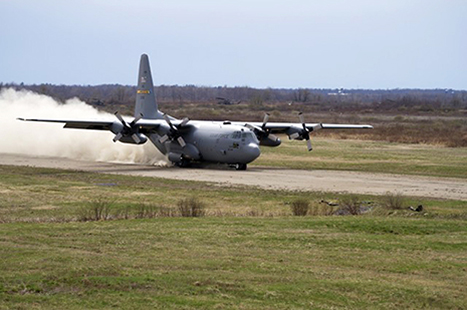
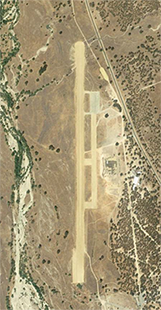
C-130 touchdown on Fort Drum Landing Zone
Source: Army.mil
Schoonover Landing Zone, Fort Hunter-Liggett
Source: Google Earth
The primary reference describing requirements for DoD Landing Zones is Chapter 7 of UFC 3-260-01, Airfield and Heliport Planning and Design.
Landing Zone runway geometry is mainly determined by the aircraft type to be operated on the airfield. Landing zones can be paved or unpaved depending on site suitability and duration of operations. Paved LZ runways can consist of flexible or rigid pavements, providing an all-weather surface suitable for sustained long-term operations. Unpaved "semi-prepared" Landing Zones may be constructed of compacted in-place soils, stabilized soil, aggregate surface course, or manufactured planks such as AM-2 matting. The construction effort required for development of a semi-prepared LZ depends on the planned operations, service life, and existing site conditions.
Comparable to fixed-wing runway design, minimum requirements for accident protection zones, clear zones, and imaginary surfaces must be established to provide a safe aircraft operational environment. Development and use of these areas is restricted and must adhere to airfield airspace and land usage criteria.
Design Considerations
The main considerations of landing zone design are existing site conditions, aircraft type, mission requirements, and length of operations.
LZ Runway Width
Runway geometry criteria for landing zones are specific to two different aircraft—C-130 or C-17 as shown in Table 7-1 of UFC 3-260-01. C-130s require a minimum 60-ft width, but C-17s require a minimum 90-ft width. Landing Zone Runway and other pavement surface geometry requirements are provided in UFC 3-260-01, Chapter 7.
LZ Runway Length
Minimum LZ runway lengths are 3,000 ft. for C-130 and 3,500 ft. for C-17. LZ Runway surface type, aircraft type, aircraft weight, and environmental conditions are factored into runway length calculation. Runway lengths vary with elevation and runway condition reading (RCR), thus higher elevations and wet conditions require longer runways. For C-17 LZs, 300 ft. overruns are required. Where no parallel taxiway is used, "hammerhead" turnarounds must be provided at both ends of the LZ runway to allow the aircraft to turn around.
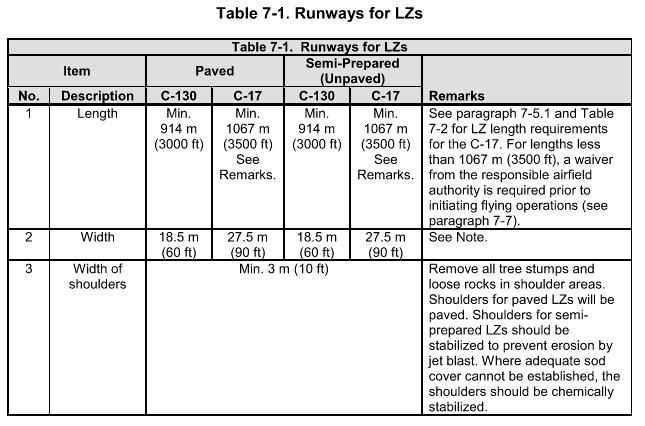
Landing Zone Length and Width Requirements
Source: UFC 3-260-01, Chapter 7
Clear Zones and Accident Potential Zones
Clear Zones are areas on the ground at the ends of runways that have a high potential for accidents. UFC 3-260-01, Table 7-7, lays out the dimensions for LZ clear zones. Clear Zones should be owned and controlled by the using Service to prevent incompatible development within the areas.
Accident Potential Zones for Landing Zones (APZ-LZ) are land-use control areas intended to promote only compatible development in areas under the approach and departure surfaces for LZ runways. Facilities restricted from this area include explosive or hazardous storage and handling facilities and troop concentrations such as housing, dining, or medical facilities. Also, any activities that produce airborne dust or smoke that would impede visibility or the safe operation of an aircraft are restricted.
Imaginary Surfaces and Obstructions
Imaginary surfaces for LZs are areas above the ground surrounding the LZ Runway that must be kept clear of objects that might damage an aircraft during approach or departure operations. Any object that protrudes through these surfaces is an obstruction and must be removed. Typical terminology for imaginary surfaces includes:
- Primary Surface
- Approach-Departure Clearance Surface
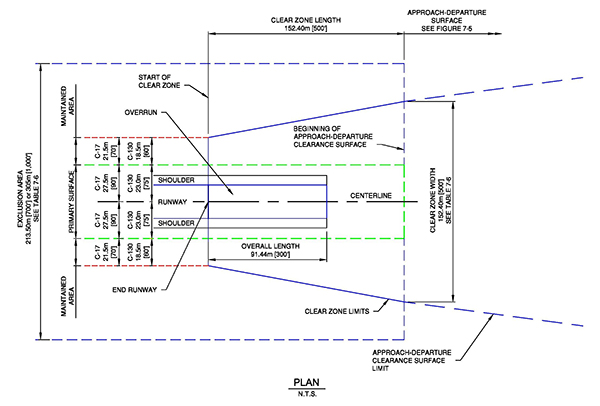
Landing Zone Primary Surface End Details
Source: UFC 3-260-01, Chapter 7
Each of these surfaces is defined in UFC 3-260-01, Chapter 3. Dimensions for these surfaces are defined in Table 7-8 of UFC 3-260-01, Chapter 7.
Grades
Minimum longitudinal and transverse slopes for LZ runways, taxiways, aprons, shoulders, graded areas, and maintained areas are intended to promote adequate drainage, prolong service life, and prevent damage to an aircraft that accidentally departs from the operational surface. UFC 3-260-01, Chapter 7 defines the requirements for the grades of the following items:
- Longitudinal Grades and Rate of Grade Change for Runways, Overruns, and Taxiways
- Transverse Slopes for Runway, Overruns, Taxiways, Shoulders, Graded Area, and Maintained Areas
- Longitudinal and Transverse Grades in the Clear Zone
Pavement Surface Design
Paved LZs may be surfaced with flexible pavement (asphalt concrete) or rigid pavement (Portland cement concrete). Flexible and rigid pavement structures are designed using UFC 3-260-02, Pavement Design for Airfields. Special consideration should be made for runways, taxiways, turnarounds, and aprons used by C-17 where 90 to 180 degree turns are made due to pavement distress caused by sharply turning aircraft. In this case, PCC pavement is preferred.
Semi-prepared (unpaved) LZ surfaces may be composed of stabilized soils, aggregate surface layers, compacted native soils, or matting. Specific evaluation guidance for semi-prepared surfaces can be found in TWPWG 3-260-03.02-19, Section 2-6. ETL 97-9, Criteria and Guidance for C-17 Contingency and Training Operations on Semi-Prepared Airfield.
Pavement durability and maintenance, and construction economics should be considered when selecting surface type for landing zones intended for long-term use.
Pavement Markings
Pavement markings are not required for LZs but are desirable for paved long-term use surfaces. Requirements for LZ pavement markings are provided by UFC 3-260-01, Chapter 7. A Landing Zone can be superimposed on an existing standard runway using special pavement markings. Applying paint to unpaved surfaces is not practical. Instead, colored survey stake chasers can be installed to outline areas for taxiing aircraft.
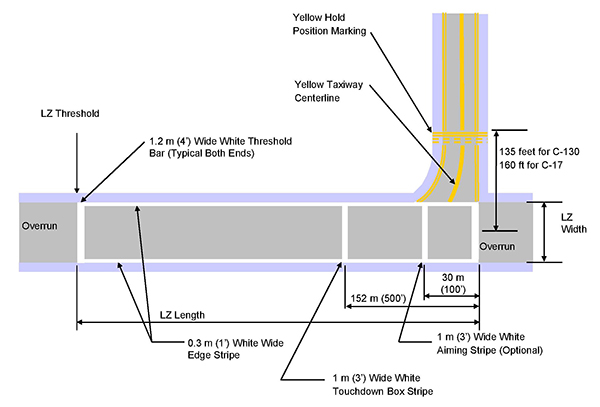
Landing Zone Painted Marking Layout
Source: UFC 3-260-01, Chapter 7
Lighting and Signs
Visual Landing Zone Marker Panels can be used to outline the LZ Runway during daytime operations. These panels are installed and laid out in accordance with AFI 13-217, Drop Zone and Landing Zone Operations.
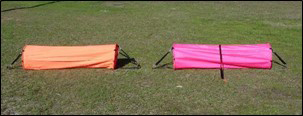
Visual Landing Zone Marker Panels
Photo Credit: AX Marker.com
When a facility is intended for long-term use, permanently installed lights can be used. These Lights are the same type and fixtures used for standard runways and laid out according to patterns defined in AFI 13-217 and defined in Chapter 7.
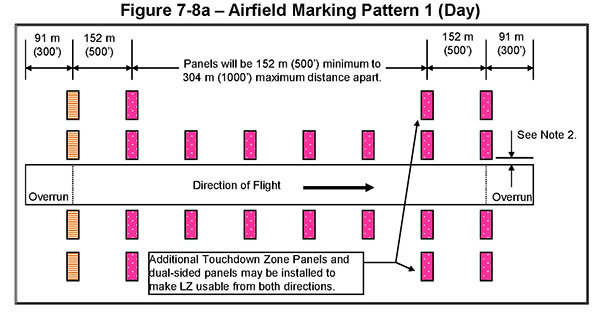
Airfield Marker Panel (AMP-1) Layout
Source: UFC 3-260-01, Chapter 7
Relevant Codes and Standards
Air Force Instructions
- AFI 13-217, Drop Zone and Landing Zone Operations








